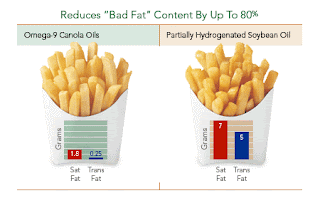You may have heard of Trans fats and Saturated fats deemed as "bad fats" and Monounsaturated (MUFA) and Polyunsaturated Fats (PUFA) receiving the title of "good fats." Bad fat and Good fat are still all FAT..so at the end of it all, is there a difference?
Fats are 1 of 3 macro-nutrients required for our bodies to function optimally. Without fat present in our body, our brain would function minimally and ultimately we would die. So why does FAT get such a bad rap?
In the 1990's fat-free or low-fat diets became the trend and people started believing that fat was the main culprit of growing waistlines. It makes enough sense, doesn't it? Eat fat, get fat. Well, as time progressed studies have proven this to be a myth.
Actually, studies have shown that the type of fat is relative to where fat deposits are distributed as well as a determining factor in out cholesterol levels. This is why "good" and "bad" fats assume their appropriate titles.
Good Fats (Monounsaturates and Polyunsaturates) are known to actually help detoxify your body from the bad fats when consumed in higher ratios. MUFAs and PUFAs help clear our arterial walls of plaque build up caused by the bad fats, therefore reducing the risk of heart disease and heart attack. In turn, the good fats also help reduce belly fat as they flush out their unhealthy counter parts.For even more information I recommend, Prevention Magazine's best selling book, The Flat Belly Diet. It is based on the principal's of including a MUFA and/or PUFA with every meal to widdle your middle.
Common MUFA/ PUFA containing foods:
- Nuts/ Seeds
- Salmon
- Avocado
- Olives
- Olive Oil
- Canola Oil
- Flax seeds/ Flax Oil
- Decontaminated Fish Oil Supplements
- Dark Chocolate
Bad Fats (Saturates and Trans) are fats which clog our arterial walls leading to the number one killer in America, Heart Disease and Heart Attack. Saturated Fats are found primarily in fatty cuts of animal proteins and full fat animal products such as Ice Cream and Milk. Trans fats are found in many favorite processed snacks such as margarines, shortenings, cakes, cookies, donuts, fried foods, chips, and even some meat products. Trans fats are fats that have been altered, CHEMICALLY, to prolong shelf-life of a product as well as give a smoothe and moist textures to products. Though pleasing to our tongues, Trans Fats are among the deadliest killer in the United States.
*****IMPORTANT*******
If an item claims to have 0 grams of trans fat, it can be a false statement and still be approved by the FDA!
Believe it or not, if an item does not have more than .5g of Trans fat/ serving, the company is not required to list any trans fats on the label. What's more: HYDROGENATED oils are code for Trans Fat! If an item claims to have 0g Trans Fats yet Hydrogenated or (worse) Partially Hydrogenated is listed in the ingredient list, TOSS IT! Those items will cut years from your life (Yes, I said YEARS) and add inches to your waist!
Most Notorious Trans Fatty Foods:
- Oreo cookies
- Deep Fried Anything (regardless of "trans-free" oil use)
- Peanut Butter (even reduced fat products that claim to be 'all-natural') READ YOUR INGREDIENT LISTS
- Any Whipped Topping in a Tub (not aerosol cans)
- Breads, rolls and buns
- cookies
- Pop-tarts
- Cakes
- Crackers (such as Ritz..even the reduced-fat/ Whole Wheat box)
- Ice Cream
- Candy
- Breakfast Cereal
- Granola Bars
- Dips or Spreads
- Chips and Snack foods (even some types of low-fat popcorn)
- Fried fast foods
- Frozen Potatoes
- Frozen Waffles
Always LOOK FOR THE BETTER OPTION. Enjoy a cookie, but grab a brand with whole grains and MUFAs rather than a deep-fried, hydrogenated, chemically- altered Oreo. (Newman's Own makes a great substitute oreo and is available in most grocery stores or online http://www.newmansownorganics.com/food_newman-os.html)
And remember... Fats are still high in calories (9 calories/gram). Enjoy modestly throughout the day.











